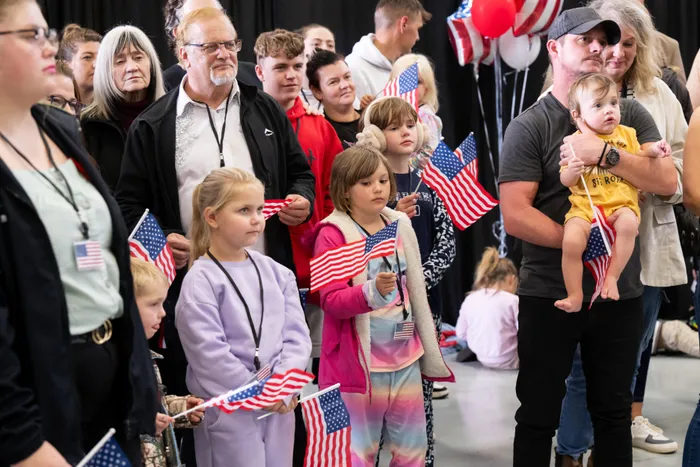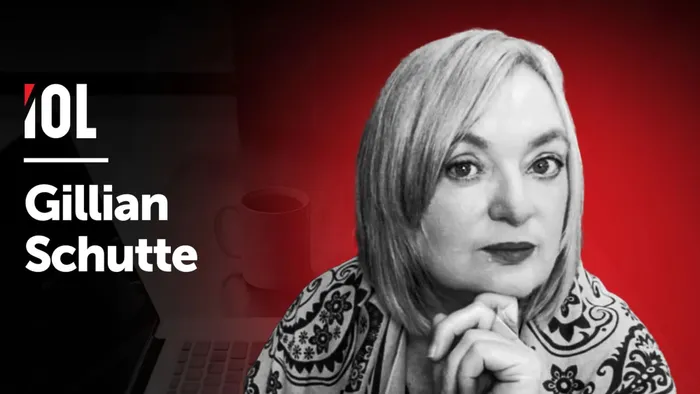
Why are white Afrikaners framed as victims while brown-skinned refugees face harsh realities? Gillian Schutte delves into the complexities of race, migration, and historical narratives in the context of Donald Trump's refugee policy.
Image: Saul Loeb / AFP
By Gillian Schutte
When Donald Trump offered refugee status to white South Africans, it became clear that whiteness still honours its own kin — globally, psychically, and politically. While brown-skinned refugees are shackled, deported, and held without trial in desert jails, Afrikaners were framed as the persecuted. Trump spoke of “genocide” against farmers and dispatched America’s welcome. The spectacle was complete — a rerun of old scripts in which the settler becomes the victim and the empire opens its gates not to the wretched of the earth, but to the discomforted custodians of colonial memory.
They left with visas, suitcases, and nostalgia — a motley procession of pilgrims fleeing transformation. They cited crime, collapse, and instability. But beneath these explanations lies the deeper reason. The mirror of post-apartheid South Africa reflects something too sharp to bear — the end of centre-stage whiteness. The erosion of assumed status. And so they trek again.
This is not the Great Trek of wagons and rifles. It is the soft trek of displaced entitlement. No fanfare. No anthem. Just the silent movement of whiteness away from discomfort and toward reabsorption into a global order that still centres it. The United States, itself built on the sacred blood of stolen land, provided the perfect terrain for this next trek. Trump’s offer was more than a policy. It was sanctuary in sameness. Whiteness recognising itself in the face of dislocation, and offering a way back into its fold.
But there is no trek without violence.
History has recorded this. My own lineage traces back to some of its early architects. Tjaart van der Walt, my ancestral uncle, moved into the Karoo and Eastern Cape interior during the frontier wars — into territories inhabited by the amaXhosa, the Khoekhoe, and the !Ora. There, land was seized, cultures were obliterated, and the rhetoric of civilisation marched hand-in-hand with brutality. My great-grandparents, Johan Pieter van der Walt and Hester Venter, were not warriors, but engineers of the white spiritual code. They helped build the first Nederduitse Gereformeerde Kerk in Middelburg — a sanctified laager in which Blackness was cast outside of God’s favour, and land theft was moralised into divine instruction.
This kind of history does not dissolve with migration. It travels. It informs the body, the posture, the speech. When Afrikaners claim refugee status, they are not only crossing borders — they are carrying a legacy of dominance that has never been publicly mourned. Psychoanalysis tells us that what is unprocessed festers. And so the guilt that was never named becomes projected as threat. The former beneficiary recasts themselves as the hunted. The discomfort of equality is rebranded as persecution.
Hermann Giliomee maps this psychic architecture in The Afrikaners: Biography of a People. He writes of the laager mentality — the encircling of identity in times of perceived threat. He shows how Afrikaner nationalism was forged through a blend of Calvinist chosenness and settler trauma. Always chosen. Always suffering. Even in power. Especially in power.
What is taking place now is another encircling. A soft siege. Except this time, it’s not around a farm or church or town. It is around the idea of whiteness itself — its right to exist unchallenged. America becomes the next laager. Its conservative suburbs, evangelical churches, and racial hierarchies offer a new enclosure in which whiteness can breathe freely again — untroubled by questions of land, labour, or history.
But there is always an outside to the laager. And it is always marked.
While white South Africans are welcomed as “refugees,” brown-skinned men with tattoos — many fleeing gang violence in Central America — are deposited into holding cells, criminalised before they speak, assumed guilty by skin and story. Their claim to safety is questioned. Their identity is scrutinised. They are reminders of how refuge is racialised. How the gates of the empire swing open only for those who mirror its founding myth.
The Afrikaner trek to America is not a neutral act. It participates in this economy of racial privilege. It reinforces the idea that some displacements matter more than others. That some pasts deserve asylum, while others are punished into silence.
And yet, those who trek now speak in hushed, melancholic tones. Their language is grief-coated, but the grief is for the fading of supremacy, not for the lives lost in its service. They mourn a world that no longer bends toward them. They carry a sadness born of de-centering.
This melancholia is not harmless. It turns outward. It becomes anger. Projection. Myth. The “farm murder” narrative, inflated beyond statistical reality, becomes a global meme — a rallying cry for white preservationists across continents. It is the displaced guilt of colonial violence, returning as spectacle.
And the violence continues — quiet, bureaucratic, and structural. Every place granted to a white South African refugee is a place denied to someone fleeing genuine structural abandonment. Every narrative of “Christian family values” masks another that is censored. Every visa is a decision about who is seen, and who is discarded.
There is always blood in the trek. Always violence in the story of movement when whiteness seeks safety in sameness. This migration is not a rupture from history — it is its continuation by other means.
The Afrikaner arrival in America will be welcomed, prayed over, and celebrated in spaces that still refuse to name conquest. But the ghosts will arrive too. The land does not forget. The unconscious does not release what has been buried. And eventually, even the trek loses its holiness.
Because without truth, the journey is just repetition. A looping spectacle of evasion dressed up as exile.

Why are white Afrikaners framed as victims while brown-skinned refugees face harsh realities? Gillian Schutte delves into the complexities of race, migration, and historical narratives in the context of Donald Trump's refugee policy.
Image: IOL
* Gillian Schutte is a South African writer, filmmaker, and critical-race scholar known for her radical critiques of neoliberalism, whiteness, and donor-driven media. Her work centres African liberation, social justice, and revolutionary thought.
** The views expressed do not necessarily reflect the views of IOL or Independent Media.
Related Topics:
